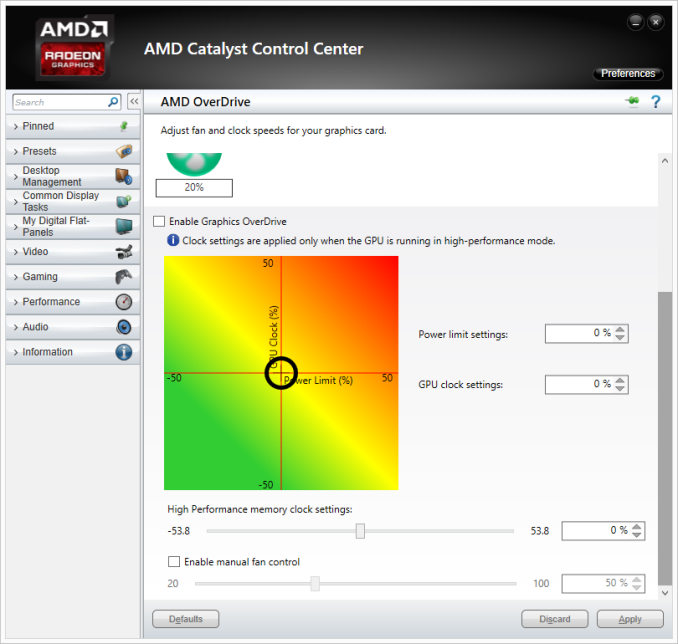Sapphire Radeon R9 290 Tri-X OC Review: Our First Custom Cooled 290
by Ryan Smith on December 24, 2013 3:45 PM EST- Posted in
- GPUs
- AMD
- Radeon
- Sapphire
- Radeon 200
290 Tri-X OC Thermal Management
Before jumping into our benchmarks, due to the significant focus we’re placing on cooling and noise for the 290 Tri-X OC (amidst the reference 290’s weaknesses) we also wanted to spend a moment discussing the card’s thermal management algorithms.
With the 290 series AMD introduced their next generation PowerTune technology, which allows for thermal management based on temperatures, power consumption, and now fan speeds. For the reference 290X in particular this was especially important as AMD used this functionality to keep fan speed noises in check despite the heavy thermal load Hawaii placed on the cooler. At the time we had assumed that everyone would use this technology even if they used different coolers, but as it turns out this isn’t the case.
For the 290 Tri-X OC Sapphire has reverted to traditional power and temperature based throttling, opting not to use the functionality of next generation PowerTune. This means that the 290 Tri-X OC does not offer the ability to throttle based on fan speeds, nor does it offer the ability to adjust the temperature it throttles at, instead throttling at Hawaii’s TjMax. This implementation caught us off guard at first since we had expected everyone to use next generation PowerTune, however as it turns out this is something that board partners get to decide for themselves on their customized cards.
Sapphire for their part has told us that based on the ample cooling performance of the Tri-X cooler that they've opted to use a traditional thermal management implementation in order to better sustain performance. Though we can’t readily test Sapphire’s statements about sustainability, we certainly can’t argue against Sapphire’s statement on the performance of their cooler. We’ll see the full breakdown in our benchmark section, but they are having absolutely no problem balancing noise and temperatures right now without next generation PowerTune.
Realistically we wouldn’t be surprised if this was also chosen because the Tri-X cooler predates the 290 series – and hence it wasn’t necessarily designed to work well with next generation PowerTune – but that’s just speculation on our part. To that end it would have been interesting to see a full next generation PowerTune implementation on this card, however it’s really just an intellectual curiosity. Out of the box the 290 Tri-X OC works just fine with a traditional thermal management implementation.
The Test
| CPU: | Intel Core i7-4960X @ 4.2GHz |
| Motherboard: | ASRock Fatal1ty X79 Professional |
| Power Supply: | Corsair AX1200i |
| Hard Disk: | Samsung SSD 840 EVO (750GB) |
| Memory: | G.Skill RipjawZ DDR3-1866 4 x 8GB (9-10-9-26) |
| Case: | NZXT Phantom 630 Windowed Edition |
| Monitor: | Asus PQ321 |
| Video Cards: |
AMD Radeon R9 290X AMD Radeon R9 290 XFX Radeon R9 280X Double Dissipation Asus Radeon R9 280X DirectCU II TOP Sapphire Radeon R9 280X Toxic AMD Radeon HD 7970 GHz Edition AMD Radeon HD 7970 NVIDIA GeForce GTX 770 NVIDIA GeForce GTX 780 NVIDIA GeForce GTX 780 Ti |
| Video Drivers: |
NVIDIA Release 331.93 AMD Catalyst 13.11 Beta v8 AMD Catalyst 13.11 Beta v9.5 |
| OS: | Windows 8.1 Pro |











119 Comments
View All Comments
Godigy - Wednesday, December 25, 2013 - link
No, it follows the reference design, but Sapphire decided to put different chokes on. You'll see that Sapphire put on CEC R15 chokes, and the reference cards uses different chokes from the same brand.sparkuss - Wednesday, December 25, 2013 - link
Looking at the picture they appear to be the same size though, don't they? Only a change in size or orientation should give a problem with water-blocks, I hope.ggathagan - Monday, December 30, 2013 - link
What's the point of buying a pricier GPU with a custom cooler if you intend on replacing the cooler with water blocks?sparkuss - Monday, December 30, 2013 - link
Basically because every time I think I'm ready to build my watercool rig, something happens and I don't follow through. But I still want to upgrade the GPU and I end up waiting too long before the reference cards are all gone. With this remaining reference I get all the benefit of the better cooling and can still hang on to it until I WC.shotgunx1x - Tuesday, December 24, 2013 - link
I know it should be soon, but any idea when we can expect these to be available?Shreddie - Tuesday, December 24, 2013 - link
Most likely Mid-Late January (that's the estimated DCII release date)Ryan Smith - Tuesday, December 24, 2013 - link
Sapphire says it should start hitting shelves at the end of this week.Mopar63 - Wednesday, December 25, 2013 - link
They seem to already be out with some etailers in Europe.Will Robinson - Wednesday, December 25, 2013 - link
Guess Blackened23 and Balla are just gonna ignore the beating the 780 gets in this review lololWhat was that about 780 overclocking again? :)
Mondozai - Wednesday, December 25, 2013 - link
The OC performance here is better than the review in Hexus.Also, you can get from mid-800s to mid-1200s in mhz on a custom-cooled GTX 780 with OC. The OC here is a lesser amount. I wonder what the performance would be on a maxed out-OC'd GTX 780 would be vs the OC that Ryan applied.